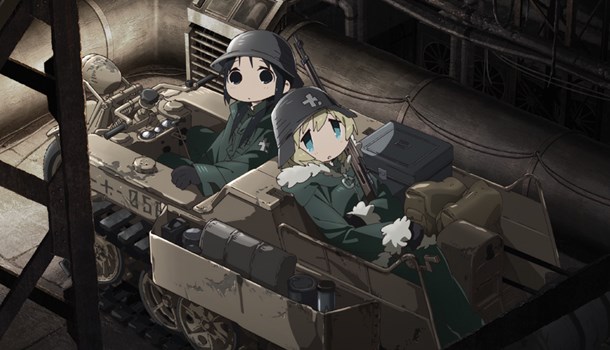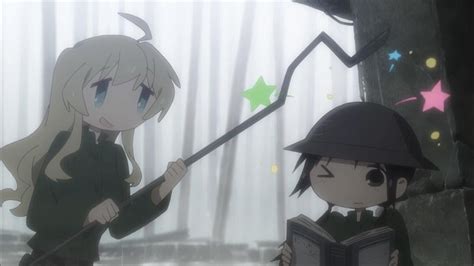
Written by Richard Durrance on 23 Mar 2021
Distributor MVM • Certificate 12 • Price 29.99
I had the same feeling about Made in Abyss that I had about Girls’ Last Tour, with absolutely no evidence to back up my gut feeling, I just thought I was going to like this. In both instances I knew almost nothing, except perhaps an element of acclaim (from whom, from where had I come by this intelligence? I’d not really been paying attention at the time) – though let’s face it acclaim doesn’t always mean you’ll like it. I was a few years late to the anime release party, too, but anyway…
So it will be obvious to anyone reading to recognise that I haven’t read the manga upon which Girls’ Last Tour is based and this year I finally got round to watching the anime. If you want go no further than this introduction, simply take this away: if like me you missed it, please correct that error. Thank you. Good bye.
Perhaps the great beauty of Girls’ Last Tour is its simplicity: Chito and Yuuri travel the cold, wet barren wasteland of the world, forever moving forward with their eyes on survival.
One of my real bugbears when it comes to anime (and anything for that matter) is the frequent desire to try and explain all the backstory in the first five minutes [imagine imperious voice]: the 12th Legion of the Ant King’s mutated super race attacked humanity and devastated it a thousand years ago! Now humanity, using [insert name of random superpower] is fighting back! And Lord SuperZoink’s eleventh child’s niece by adoption though having lost her memory and been kidnapped by, then raised by, bears as a child is leading the revolution though not knowing her superpower exists… etc. etc. etc.
Thankfully Girls’ Last Tour gives us no such superfluous history. Beyond one short flashback of an old man, their grandfather, aiding their escape from their home that is under attack (by who? we don’t know, it doesn’t matter). What’s wonderful about Girls’ Last Tour is that in this post-apocalyptic wilderness we, the audience, are just as lost, just as lacking in history as our two protagonists. There are some stories that work better when the characters know more than us or we them, but watching Girls’ Last Tour it feels essential that we’re both equally ignorant and finding our way. In part this means we really cannot guess what’s going to happen. Considering the first episode has one very casual and striking moment of conflict, Girls’ Last Tour really opens up space for the world to go into many different directions. Will we find conflicts and war? Will society flourish elsewhere? Are there monsters? Where is Lord Superzoink's progeny?
Look away for spoilers… As the answer is not really any of the above. The other great strength of Girls’ Last Tour is perhaps the least expected one: not very much actually happens. Even in a relatively short 12 episode anime you might think that would be the death knell, the nail in the coffin, the yawn as you turn the series off, but no, Girls’ Last Tour has the unusual virtue of making the lack of detail fascinating. It also means you can focus on character, dig in deep. It’s a bit like my favourite episode of Ergo Proxy: Busy Doing Nothing. It’s a full episode dedicated to Re-l’s observation of her two fellow passengers, who she cannot understand or empathise with, while they are all stranded on their journey; Re-l’s mind slowly crumbles under the stress of her powerlessness to affect nature (their ship is wind powered and nothing can make the wind blow). But by the end of the episode she has moved on, emotionally, mentally, though as the title of the episode suggests not very much actually happens. It’s all about observation, the detail, of moments of characterisation that inexplicably perform that almost alchemically difficult action of getting under your skin. I thought Girls’ Last Tour was a classic "get under your skin" series, and if it doesn’t you may well be entirely indifferent to it.
So what, you may be thinking, about our two protagonists: Chito and Yuuri? After the short setup of escaping an attack, they are now travelling on their own with only their transportation, the Kettenkrad. It’s worth pausing to consider the Kettenkrad because it’s practically the third protagonist in and of itself. (If so then the world is the fourth.) It’s like a small open top tank with a motorbike at the front. I did actually Google it and it exists, a German creation, and it’s almost cute – as much as a tank can be cute and I’m no particular fetishist when it comes to machines or forms of automobiles. As a vehicle it suits the characters and gives them a place to live: it is quite literally their mobile home. However, it's a fragile base: it has no shelter, it requires fuel, it can break down, it’s small, and in this vast world about us oddly vulnerable. Just like our two protagonists. Returning to them then, Chito is the driver of the Kettenkrad, while Yuuri is in the back, more often resting than not. It’s a good metaphor because Chito is very much the thoughtful one, the one who can read, the one who keeps a journal. She may also be prone to overthinking but she’s precise and likely to plan ahead. Yuuri on the other hand is in some ways more adept at survival because there’s an element of everything washing over her. If there is food she would be more likely to eat it and not think about tomorrow; she can be unintentionally thoughtless and she’s more aggressive – evident in her being the one that carries the rifle. Yuuri can’t see the value, beyond what they mean to Chito, in things such as words and books and history. So you can see our protagonists as chalk and cheese or two parts of a functional unit. You sense the characters are able to get by because of their respective traits. Without Yuuri’s cheerfulness and general obliviousness to the destruction, you suspect Chito would collapse into introspection. Equally without Chito’s thoughtfulness and ability to plan, you feel Yuuri would end up starving in a corner (albeit you suspect quite happily and she’d not complain, except when hungry). So they’re beautifully complimentary characters, which is important because almost the whole series is just these two and their travelling through the world on the Kettenkrad.
As we travel with our protagonists, they do meet the odd stranger along the way, human or otherwise, that may help or need to be helped. Like our two protagonists they have their own need to move forward, and tend to have their own singular, often obsessive purpose. It seems to be a theme that those few that survive latch onto a dream, an activity that can define them and perhaps keep them sane, because the world clearly has nothing else it can give them. I enjoyed the general lack of conflict; it would be easy for the series to pit Chito and Yuuri against your more Mad Max (think Road Warrior and Fury Road) type apocalyptic villains but instead the story focuses on the dreamers, and has a rather more optimistic perspective: just because the apocalypse has finally happened one doesn’t have to renounce one’s humanity. That’s not to say that the series is not without conflict but that’s more the conflict of character, of personality between Chito and Yuuri that comes of being complementary and also of being friends. And the conflict of everyone against a world that is no longer welcoming and often literally collapsing.
So if Yuuri and Chito are our protagonists, and the Kettenkrad a third then the next major player is the world itself. Mainly it’s a beautifully rendered collapse, this arena we explore: whether through darkened industrial, seemingly non-stop buildings or cities that spiral off into towers, which lead to level after level of labyrinthine metropolises or across snowy plains covered in broken vehicles, expect a palette of muted greys and greens and browns. It’s lovely to look at and feels very real and fragile. Sometimes the fragility is literal, and by corollary dangerous to our protagonists. It’s not a one trick pony though and the world can sometimes open up mysteries; or rather our protagonists will find mysteries and moments of awe and wonder even if these are fragmentary and no more than a pit stop on their remorseless journey forward to… Somewhere.
If there is a message to be drawn from Girls’ Last Tour it’s regardless of circumstance humanity’s capacity, despite setbacks, to keep moving forward and to do so in a quietly gentle way. Though the series is not without conflict, it tends to wear its good humour and good nature on its sleeve, being almost ironically optimistic despite the evident crumbling world devoid of humanity that is slowly rotting to bits. And our characters do learn and adapt, probably most specifically Yuuri, being the one most likely to be thoughtless. But then who wouldn’t learn to change when faced with perhaps the last fish on Earth! I would. Hopefully…
Like the Kettenkrad, Girls’ Last Tour just rolls past but in the best most quietly joyous way possible. For a series that could be remarkably depressing and melancholy I found Girls’ Last Tour to be entirely the opposite. It’s not a laugh out loud series but our protagonists are mainly grounded in this destroyed world and accepting of it. They’re not strangers to their annihilated world and so are dealing with it in many ways just as you might when going to work. The world – like work sometimes – is something to get through, day-to-day, week to month, month to year. Just as you might have to work to pay the bills, they have to keep travelling to find fuel, travelling to find food, to find hints of the world that once was. To them it’s pedestrian and they never seem to let it interfere with them overmuch. So there’s a real optimism, and frankly the series has more charm in its first five minutes, more charm in just the Kettenkrad let alone Chito and Yuuri, than another series can hope to accumulate over four or five series. Also 12 episodes feels like just the right length, the pacing being never too swift or too slow. When it ends you’re left with a sense of curious hopefulness because no matter what, these two young girls always seem to find a way to survive and be happy about it. Considering their life versus our insane bulk buying of toilet paper on the possibility that you might be asked to self-isolate because of the coronavirus, makes us seem like very shabby people by comparison. I’d rather have Chito in Yuuri shop in my supermarket, because you know they take just as much toilet paper as they need despite the end of the world. OK, Yuuri would try and grab it all, but Chito would make her act sensibly.

See, complementary.

Long-time anime dilettante and general lover of cinema. Obsessive re-watcher of 'stuff'. Has issues with dubs. Will go off on tangents about other things that no one else cares about but is sadly passionate about. (Also, parentheses come as standard.) Looks curiously like Jo Shishido, hamster cheeks and all.
by Ross Locksley on 21 Dec 2025
by Ross Locksley on 25 Nov 2025
by Ross Locksley on 24 Nov 2025
by Ross Locksley on 11 Nov 2025
by Ross Locksley on 08 Nov 2025
by Ross Locksley on 07 Nov 2025
by Ross Locksley on 05 Nov 2025
by Jamie Morris on 27 Oct 2025